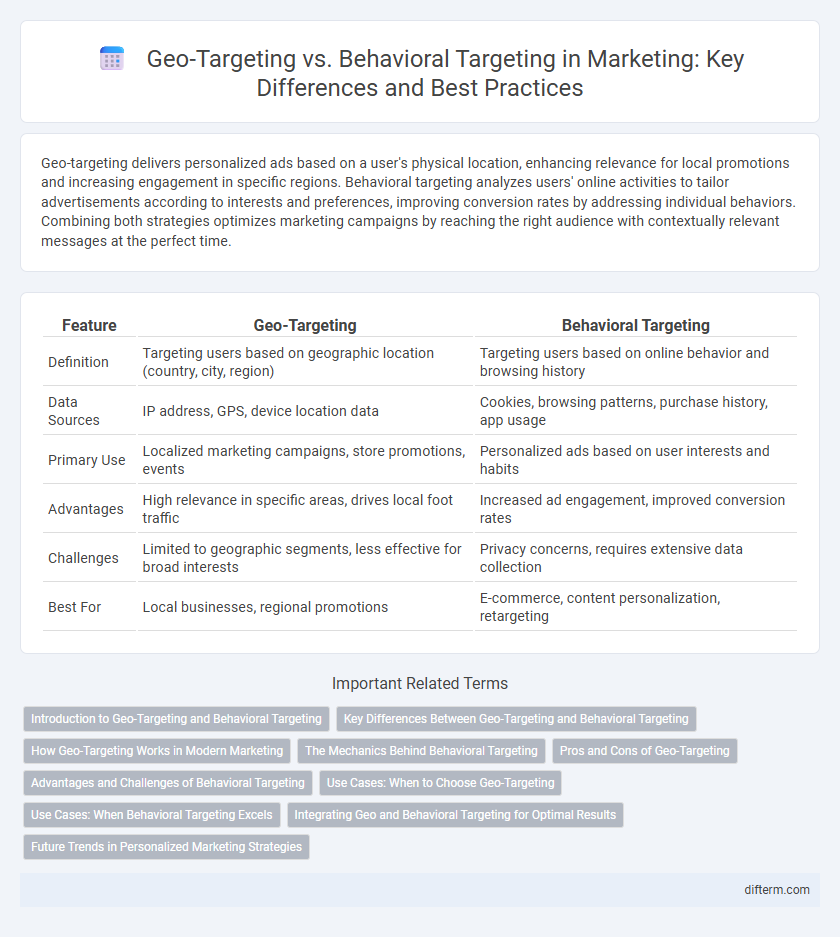Geo-targeting delivers personalized ads based on a user's physical location, enhancing relevance for local promotions and increasing engagement in specific regions. Behavioral targeting analyzes users' online activities to tailor advertisements according to interests and preferences, improving conversion rates by addressing individual behaviors. Combining both strategies optimizes marketing campaigns by reaching the right audience with contextually relevant messages at the perfect time.
Table of Comparison
| Feature | Geo-Targeting | Behavioral Targeting |
|---|---|---|
| Definition | Targeting users based on geographic location (country, city, region) | Targeting users based on online behavior and browsing history |
| Data Sources | IP address, GPS, device location data | Cookies, browsing patterns, purchase history, app usage |
| Primary Use | Localized marketing campaigns, store promotions, events | Personalized ads based on user interests and habits |
| Advantages | High relevance in specific areas, drives local foot traffic | Increased ad engagement, improved conversion rates |
| Challenges | Limited to geographic segments, less effective for broad interests | Privacy concerns, requires extensive data collection |
| Best For | Local businesses, regional promotions | E-commerce, content personalization, retargeting |
Introduction to Geo-Targeting and Behavioral Targeting
Geo-targeting leverages geographic data such as IP addresses, GPS location, or regional demographics to deliver tailored marketing messages to users based on their physical location. Behavioral targeting, on the other hand, analyzes user behavior patterns including browsing history, purchase behavior, and online interactions to create personalized advertising experiences. Both strategies enhance marketing effectiveness by aligning content with user context, but geo-targeting emphasizes spatial relevance while behavioral targeting focuses on individual preferences and actions.
Key Differences Between Geo-Targeting and Behavioral Targeting
Geo-targeting focuses on delivering content and ads based on a user's physical location using IP addresses, GPS data, or Wi-Fi signals, allowing marketers to tailor messages for specific regional demographics or local events. Behavioral targeting collects and analyzes user data such as browsing history, purchase behavior, and online interactions to create personalized marketing strategies that predict consumer interests and preferences. The key difference lies in geo-targeting's emphasis on location-based segmentation versus behavioral targeting's focus on individual user actions and intent.
How Geo-Targeting Works in Modern Marketing
Geo-targeting in modern marketing utilizes IP addresses, GPS data, and device locations to deliver hyper-localized content and advertisements tailored to a user's specific geographic area. This approach enhances relevance by matching promotions with regional preferences, cultural nuances, and local events, resulting in higher engagement rates. Marketers integrate geo-targeting with real-time analytics to optimize campaign timing and dynamically adjust offers based on location-specific trends and consumer behaviors.
The Mechanics Behind Behavioral Targeting
Behavioral targeting relies on data collected from users' online activities, such as browsing history, search queries, and purchase patterns, to deliver personalized advertisements. Algorithms analyze this user data to segment audiences and predict future behaviors, enabling marketers to craft highly relevant campaigns that improve engagement and conversion rates. Unlike geo-targeting, which targets users based on physical location, behavioral targeting provides deeper insights into individual preferences and intent.
Pros and Cons of Geo-Targeting
Geo-targeting enables marketers to deliver location-specific ads, increasing relevancy and boosting local engagement by targeting users based on their geographic location. However, its limitations include reduced effectiveness in reaching broader or mobile audiences and potential privacy concerns related to location tracking. Despite these drawbacks, geo-targeting remains a powerful tool for businesses aiming to attract customers within specific regions or local markets.
Advantages and Challenges of Behavioral Targeting
Behavioral targeting leverages user data such as browsing history, purchase behavior, and online interactions to deliver highly personalized ads, resulting in increased engagement and conversion rates. This method allows marketers to segment audiences with precision, enhancing ROI through relevance and timing. Challenges include privacy concerns, data accuracy issues, and the necessity to comply with regulations like GDPR and CCPA, which can limit data collection and targeting capabilities.
Use Cases: When to Choose Geo-Targeting
Geo-targeting is most effective for businesses seeking to reach local customers, such as restaurants, retail stores, and event organizers aiming to drive foot traffic and increase in-person sales. It excels in delivering region-specific promotions, seasonal offers, and location-based services that require precise geographic relevance. Businesses should choose geo-targeting when location is a key factor in consumer decision-making or when compliance with regional regulations demands targeted messaging.
Use Cases: When Behavioral Targeting Excels
Behavioral targeting excels in personalized marketing campaigns where understanding user preferences and past actions drives higher engagement, such as retargeting abandoned carts in e-commerce or promoting content based on browsing history. It enables marketers to deliver dynamic ads tailored to individual user behaviors, increasing conversion rates and customer loyalty. This approach outperforms geo-targeting in scenarios requiring granular audience segmentation beyond location data.
Integrating Geo and Behavioral Targeting for Optimal Results
Integrating geo-targeting and behavioral targeting enables marketers to deliver highly personalized campaigns by combining location data with user behavior insights. This approach enhances audience segmentation accuracy, increases engagement rates, and improves conversion by addressing both where users are and what actions they take online. Leveraging advanced analytics platforms that merge real-time geographic information with behavioral patterns drives more efficient ad spend and maximizes ROI.
Future Trends in Personalized Marketing Strategies
Future trends in personalized marketing strategies emphasize integrating geo-targeting with behavioral targeting to enhance precision in audience segmentation. Leveraging AI-driven analytics enables marketers to predict consumer needs based on location data combined with online behavior patterns, resulting in highly relevant content delivery. This fusion advances real-time personalization, driving higher engagement and conversion rates in digital advertising campaigns.
geo-targeting vs behavioral targeting Infographic

 difterm.com
difterm.com